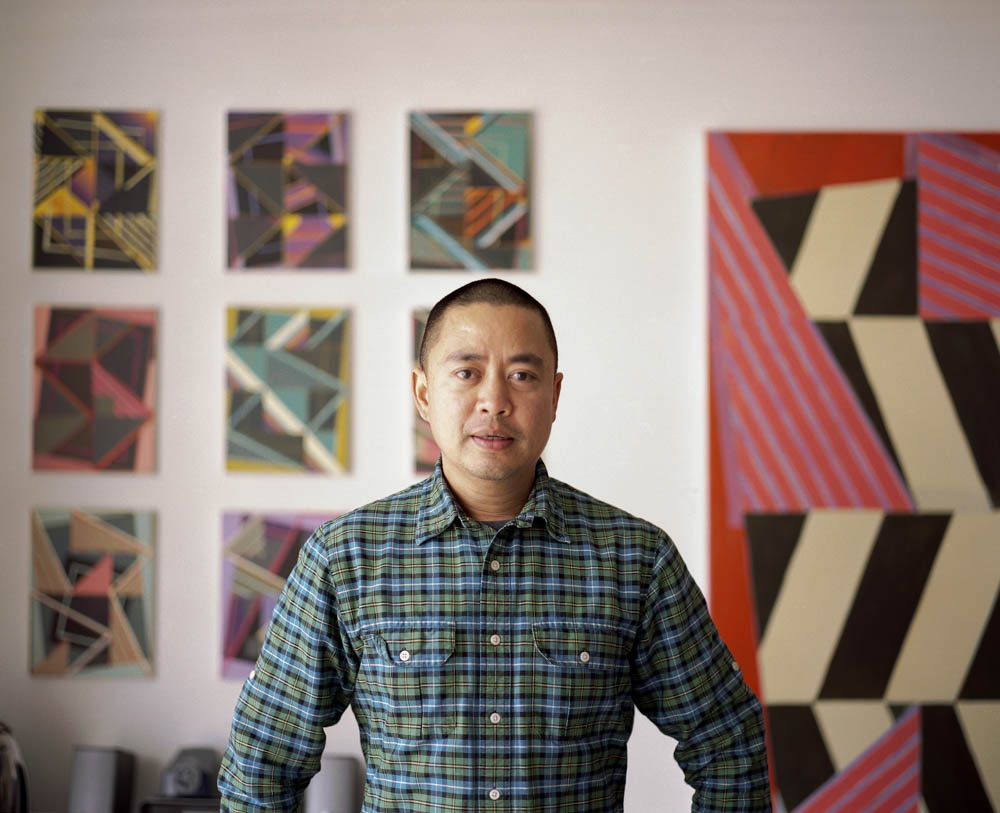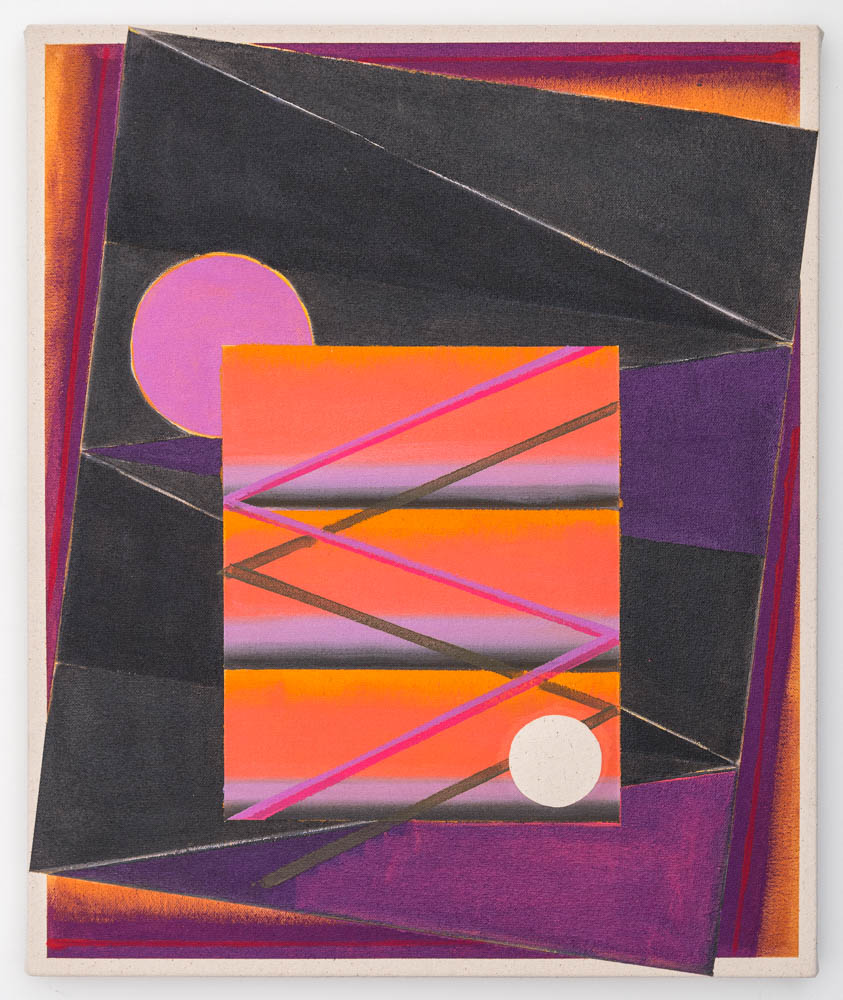Paolo Arao
In 2017 I painted one canvas every week for the entire year. And each 18 x 15 inch painting was completed in one session. I enjoy working with self-imposed restraints and use these restrictions as seeds for limitless possibilities. My paintings are intentionally uncomfortable yet playful in their use of color and geometry. I love seeing ugly and beautiful colors collapsing happily or awkwardly into one another to create a queer, dynamic and shifting space.
Paolo in the studio.
Installation photo of Paolo's solo exhibition "52 Weeks" currently on view at Barney Savage Gallery in New York City. Courtesy of Barney Savage Gallery, NYC
Interview with Paolo Arao
Questions by Eric Hancock
Hi Paolo, thanks for talking with me. This is my inaugural interview so let's get this started!
Hi Eric, happy to be the first!
Can you tell us a bit about your background and what motivated you to become an artist? How has your work evolved over time up to this moment?
I was born in the Philippines and moved to the US when I was two years old. My father was in the US Navy so I grew up in Hawaii, Florida and Virginia. I received my BFA in Painting from Virginia Commonwealth University in Richmond. And I moved to NYC in the fall of 2000 immediately after a residency at The Skowhegan School of Painting and Sculpture. I’ve been living and working in Brooklyn for the past 18 years.
I started playing the piano at a very early age. In high school I attended the Governor’s Magnet School for the Arts in Norfolk, VA to study music. I was surrounded by other musicians, visual artists, dancers and performing artists. I went on to study Music Performance at Virginia Commonwealth University. I aspired to be a classical pianist, but after the first semester of my freshman year, I became curious about the visual arts.
Since graduating from VCU with a BFA, my work has evolved over the years. My work has gone from gridded abstractions in oil to representational and photorealistic graphite drawings on paper and then back to painting with acrylic. In recent months I’ve been working with acrylic paintings, sewn textiles and fabric collages.
What's your favorite medium for the preliminary planning stages of painting? Do you make drawings?
I make drawings in a small sketchbook. Sometimes my paintings are a conglomeration of parts taken from multiple sketchbook drawings. More recently my work has become more improvisatory and I let the paintings emerge and unfold during the process of making without too much planning.
Your work taps into a nostalgia for older recognizable art historical forms, which seems to be a prevalent approach for a lot of engaging painters these days. How does your appreciation for art and design history play into your formal decisions? I see some similarities between your painting and for or instance quilt design, how much of your inspiration doesn't strictly fall under the category of Fine Art?
My work is rooted in geometric abstraction. There’s a lineage of history that I’m both working with and against. I’m experimenting with ways to explore the elastic concept of queerness through abstraction – specifically geometric abstraction. And one of the questions I ask myself in the studio is “Can abstraction or geometry be gay?” Working with textiles feels like an appropriate material to help soften the geometry and “straight” system of the grid that I’ve been working with throughout the years. Quilts and textiles have been a rich reference source for me as well.
This is somewhat of an unpopular question, but have there been any fashionable approaches to painting from the last several years that bother you. I'm somewhat of a fanboy, but I like to keep my critical faculties sharp, so to speak. Feel free to plead the fifth here :)
I try not to get too bothered by or caught up with what’s fashionable. Taste in the art world is cyclical and eventually almost everything becomes fashionable at one point or another. I believe in what I’m doing and why I’m making the work I make.
Let's talk about your color usage—do you lay out your color schemes beforehand, and how strictly do you adhere to that in the process of painting?
Color is both personal and political. I sometimes pre-mix a few main colors and then create secondary or tertiary mixes as I go along. I admit that there are colors that I gravitate to more than others, but I like to mix things up by playing with colors that are intentionally ugly or jarring and placing them next to other colors to create a vibration or dissonance.
Are you looking at any current painters whose work excites you?
This list is far too long and constantly changing! Although he’s not a current painter, a painter I’m currently looking at is Alan Shields.
Do you make one painting at a time, or do you have multiple works going at once?
I like working on multiple projects at the same time. I bounce back and forth between making paintings, sewn textile constructions and fabric collage. And I’ve been working on a trilogy of yearlong projects that involve making one piece at a time. Each of these projects has a set of self-imposed parameters regarding scale, frequency and duration.
The first in this trilogy is Yearbook (2016.) I painted one 12 x 9 inch painting every single day for the entire year. There are 366 paintings in total (it was a leap year.) Each painting was completed in the span of one hour. The second in the trilogy is 52 Weeks (2017.) For this project I painted one 18 x 15 inch painting for each week of the year. Each painting was completed in a single session—a session lasted anywhere from 3–10 hours. All 52 paintings from this project are currently on view in my solo show at Barney Savage Gallery in TriBeCa (until July 22nd.) The third part of the trilogy will begin in 2019 and will consist of twelve large scale painted textile constructions. Stay tuned!
I'm going out on a limb here, but the images seem to have a diurnal quality-with an inherent time of day. There are orbs and implied contrasts between shade and light. Do you think about that at all?
A large majority of the paintings from my “52 Weeks” series were completed during the morning or early afternoon. I am most productive in the morning and I’m rarely in my studio in the evenings.
Detail of the installation of Paolo's solo exhibition "52 Weeks" currently on view at Barney Savage Gallery in New York City. Courtesy of Barney Savage Gallery, NYC
You're playing with transparency and opacity, punching holes in the foreground and skewing elements to reveal the background. I'm thinking of the two paintings Departures and Troubled Light in which the background jumps into the foreground in a kind of hypnagogic reversal. Is there a conceptual underpinning for the spatial skewing?
The skewing, transparencies and perceptual shifts are meant create an intentionally uncomfortable yet playful space in my paintings. There’s an uneasiness or restlessness to the forms. It’s like they’re dancing or resisting stillness. Some of the forms push against or penetrate each other. I want the viewer to see the many layers of the painting and not just what’s on the surface.
In my own work, abrupt detours and periodic denials have produced a variety of failed experiments and divergent material. Did you have much of a growing pain phase, or has your development been fairly smooth?
I embrace failures and mistakes. It’s become an integral part of my process. Sometimes these failures become catalysts for another work or body of work. I’m really interested in the intersection of intention and imprecision and maybe doing things the wrong way to reveal something new and deeply personal.
Does doubt ever factor into the making of the work? At which part of the process do you feel the strongest positive feelings for your work?
Doubt (and fear) are motivating factors. I’m constantly questioning my moves. Sometimes if I think it’s a wrong move, I’ll gravitate towards that. I often take three left turns instead of one right turn to get to where I need to go. I like to get lost in the work and find my way through.
Art business versus making, what's the split look like for you?
I try to take care of all the business stuff before I head out to the studio in the morning and then maybe check back in during the evenings. I prefer to spend the majority of my day focusing my energy on making.
What's your studio like. Do you have specific light requirements or a super customized set-up?
Right now, I’m on a residency at the Wassaic Project—so my studio is currently in a barn!
I’m grateful to be participating in six residencies this year. When I’m not at a residency, my studio is in Bed Stuy a very short walk from Clinton Hill where my husband and I live. My studio is minimally furnished with a work table, rolling cart and chair. I try to only have the materials I need to work with on my current projects. I keep older paintings and miscellaneous studio supplies in a storage space.
Do you listen to music when you work?
I don’t listen to music as often these days. However, when I do it’s usually an instrumental playlist on Spotify that begins with Philip Glass or Nils Frahm. But other times I’ll listen to pop music or 90’s R&B if I’m doing something that doesn’t require much thinking or decision making.
Do you talk shop talk with friends? I live in L.A. And mostly my friends and I just gossip a lot. It seems like post grad school the contentiousness of art practice dissipates a bit. Reading difficult and polarizing theory seemed to help ratchet up the tension when I was in school. Do you do stuff like that, introduce contentiousness into your process?
I can’t say that I do. I did not go to grad school—it didn’t seem right for me. Instead, I went to an artist residency at the Vermont Studio Center right after graduating from VCU in 1999. I’ve done a number of other residencies over the years as well as studio visits with other artists. It’s been a great way to meet artists from all over the world and create an expanded network and community. I’ve learned so much from the lived experiences of other artists. It’s definitely helped my process in the studio. Most of my conversations have been constructive and critical in helping to navigate ways of surviving as an artist outside of academia.
At the end of the making, towards the reception phase, do you feel precious about the work's showing, or are you on to the next creative phase fairly quickly?
Once a work is done, I’m usually on to the next thing. I try not to be too precious about each painting. I know there’s going to be another painting and then another and so forth. I’ve learned to let go more easily.
I love your work, thanks so much for taking the time to chat with me!
My pleasure!
Thanks so much for sharing your work and talking with us!
To find out more about Paolo and his work, check out his website.











